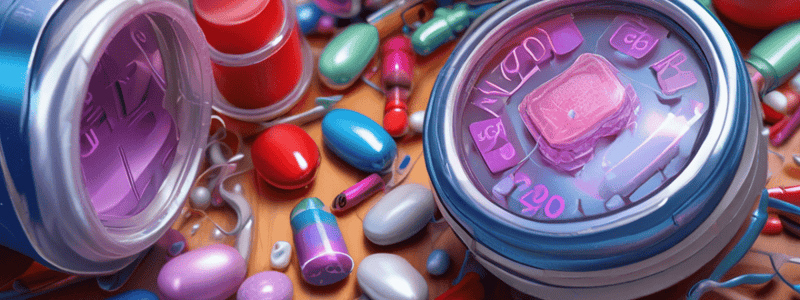Podcast
Questions and Answers
Which type of agent may be the only effective management of hypotension in patients treated with TCAs?
Which type of agent may be the only effective management of hypotension in patients treated with TCAs?
- Direct-acting agents like norepinephrine (correct)
- Alpha-1 adrenergic antagonists
- Centrally acting anticholinergics
- Opioids and barbiturates
Why should the dose of exogenous epinephrine be adjusted in patients treated with TCAs during anesthesia with a volatile anesthetic?
Why should the dose of exogenous epinephrine be adjusted in patients treated with TCAs during anesthesia with a volatile anesthetic?
- To potentiate the effects of the anesthetic
- To decrease blood pressure
- To prevent cardiac arrhythmias (correct)
- To avoid respiratory depression
Which anticholinergic agent is theoretically less likely to interact with TCAs and cause postoperative delirium and confusion?
Which anticholinergic agent is theoretically less likely to interact with TCAs and cause postoperative delirium and confusion?
- Scopolamine
- Atropine sulfate
- Glycopyrrolate (correct)
- Physostigmine
What potential risk is associated with giving TCAs in conjunction with alpha-1 adrenergic antagonists?
What potential risk is associated with giving TCAs in conjunction with alpha-1 adrenergic antagonists?
Why should the doses of opioids and barbiturates be decreased when used with TCAs?
Why should the doses of opioids and barbiturates be decreased when used with TCAs?
What makes TCA overdose life-threatening and able to progress rapidly?
What makes TCA overdose life-threatening and able to progress rapidly?
When administering sympathomimetic agents to patients recently started on a tricyclic antidepressant (TCA), which of the following responses should be anticipated?
When administering sympathomimetic agents to patients recently started on a tricyclic antidepressant (TCA), which of the following responses should be anticipated?
Which of the following statements is true regarding the administration of sympathomimetic agents in patients chronically treated with tricyclic antidepressants (TCAs)?
Which of the following statements is true regarding the administration of sympathomimetic agents in patients chronically treated with tricyclic antidepressants (TCAs)?
When administering direct-acting sympathomimetics to patients on tricyclic antidepressants (TCAs) for more than 6 weeks, which of the following dosing strategies is recommended?
When administering direct-acting sympathomimetics to patients on tricyclic antidepressants (TCAs) for more than 6 weeks, which of the following dosing strategies is recommended?
Which of the following statements accurately describes the interaction between tricyclic antidepressants (TCAs) and indirect-acting sympathomimetic agents?
Which of the following statements accurately describes the interaction between tricyclic antidepressants (TCAs) and indirect-acting sympathomimetic agents?
In patients chronically treated with tricyclic antidepressants (TCAs), which of the following mechanisms may contribute to the reduced effectiveness of conventional sympathomimetics in restoring systemic blood pressure?
In patients chronically treated with tricyclic antidepressants (TCAs), which of the following mechanisms may contribute to the reduced effectiveness of conventional sympathomimetics in restoring systemic blood pressure?
Which of the following statements accurately describes the interaction between tricyclic antidepressants (TCAs) and sympathomimetic agents?
Which of the following statements accurately describes the interaction between tricyclic antidepressants (TCAs) and sympathomimetic agents?
Which enzyme systems are involved in the metabolism of Tricyclic Antidepressants (TCAs)?
Which enzyme systems are involved in the metabolism of Tricyclic Antidepressants (TCAs)?
Which of the following is NOT a common cardiovascular effect of Tricyclic Antidepressants (TCAs)?
Which of the following is NOT a common cardiovascular effect of Tricyclic Antidepressants (TCAs)?
What is the primary mechanism of action of Tricyclic Antidepressants (TCAs) in enhancing noradrenergic and serotonergic transmission?
What is the primary mechanism of action of Tricyclic Antidepressants (TCAs) in enhancing noradrenergic and serotonergic transmission?
Which of the following is a prominent adverse effect associated with Tricyclic Antidepressants (TCAs) at high doses?
Which of the following is a prominent adverse effect associated with Tricyclic Antidepressants (TCAs) at high doses?
What adverse effect can be life-threatening with Tricyclic Antidepressants (TCAs) overdose due to Na+ channel blockade?
What adverse effect can be life-threatening with Tricyclic Antidepressants (TCAs) overdose due to Na+ channel blockade?
Which side effect is NOT typically associated with Tricyclic Antidepressants (TCAs) use?
Which side effect is NOT typically associated with Tricyclic Antidepressants (TCAs) use?
What symptoms may occur upon abrupt cessation of Tricyclic Antidepressants (TCAs) treatment?
What symptoms may occur upon abrupt cessation of Tricyclic Antidepressants (TCAs) treatment?
Which type of Tricyclic Antidepressant (TCA) primarily inhibits the reuptake of norepinephrine?
Which type of Tricyclic Antidepressant (TCA) primarily inhibits the reuptake of norepinephrine?
'Quinidine-Like effect' associated with Tricyclic Antidepressants (TCAs) refers to what cardiac issue?
'Quinidine-Like effect' associated with Tricyclic Antidepressants (TCAs) refers to what cardiac issue?
'Inhaled anesthetics' are listed as a drug interaction caution with Tricyclic Antidepressants (TCAs) due to what reason?
'Inhaled anesthetics' are listed as a drug interaction caution with Tricyclic Antidepressants (TCAs) due to what reason?
Match the Tricyclic Antidepressant (TCA) with its primary clinical use:
Match the Tricyclic Antidepressant (TCA) with its primary clinical use:
Match the Tricyclic Antidepressant (TCA) with its mechanism of action:
Match the Tricyclic Antidepressant (TCA) with its mechanism of action:
Match the Tricyclic Antidepressant (TCA) with its adverse effect:
Match the Tricyclic Antidepressant (TCA) with its adverse effect:
Match the Tricyclic Antidepressant (TCA) with its pharmacokinetic characteristic:
Match the Tricyclic Antidepressant (TCA) with its pharmacokinetic characteristic:
Match the drug interaction caution with Tricyclic Antidepressants (TCAs) with the reason:
Match the drug interaction caution with Tricyclic Antidepressants (TCAs) with the reason:
Tricyclic Antidepressants (TCAs) are commonly used as first-line agents for depression due to their tolerable adverse effect profile.
Tricyclic Antidepressants (TCAs) are commonly used as first-line agents for depression due to their tolerable adverse effect profile.
TCAs primarily inhibit the reuptake of serotonin only.
TCAs primarily inhibit the reuptake of serotonin only.
Tricyclic Antidepressants (TCAs) have short elimination half-lives ranging from 1-12 hours.
Tricyclic Antidepressants (TCAs) have short elimination half-lives ranging from 1-12 hours.
TCAs are metabolized in the kidneys rather than the liver.
TCAs are metabolized in the kidneys rather than the liver.
TCAs do not have any anticholinergic effects.
TCAs do not have any anticholinergic effects.
Abrupt cessation of TCA treatment does not lead to withdrawal symptoms.
Abrupt cessation of TCA treatment does not lead to withdrawal symptoms.
Drug interactions with TCAs are not significant and do not require caution.
Drug interactions with TCAs are not significant and do not require caution.
Patients on TCAs should be given MAOIs simultaneously to enhance their therapeutic effects.
Patients on TCAs should be given MAOIs simultaneously to enhance their therapeutic effects.
Tricyclic Antidepressants (TCAs) can be safely used in patients with cardiac disease without monitoring.
Tricyclic Antidepressants (TCAs) can be safely used in patients with cardiac disease without monitoring.
TCAs have no impact on the seizure threshold of individuals.
TCAs have no impact on the seizure threshold of individuals.
Explain the 'Quinidine-Like effect' associated with Tricyclic Antidepressants (TCAs) and its clinical significance.
Explain the 'Quinidine-Like effect' associated with Tricyclic Antidepressants (TCAs) and its clinical significance.
What is the rationale for avoiding the concomitant use of Tricyclic Antidepressants (TCAs) and Monoamine Oxidase Inhibitors (MAOIs)?
What is the rationale for avoiding the concomitant use of Tricyclic Antidepressants (TCAs) and Monoamine Oxidase Inhibitors (MAOIs)?
Explain the mechanism by which Tricyclic Antidepressants (TCAs) can reduce the effectiveness of conventional sympathomimetic agents in restoring systemic blood pressure in patients chronically treated with TCAs.
Explain the mechanism by which Tricyclic Antidepressants (TCAs) can reduce the effectiveness of conventional sympathomimetic agents in restoring systemic blood pressure in patients chronically treated with TCAs.
Describe the potential cardiovascular adverse effects associated with Tricyclic Antidepressants (TCAs) and explain the underlying mechanisms.
Describe the potential cardiovascular adverse effects associated with Tricyclic Antidepressants (TCAs) and explain the underlying mechanisms.
Explain the potential drug interactions between Tricyclic Antidepressants (TCAs) and sympathomimetic agents, and the recommended dosing strategy when administering these agents concurrently.
Explain the potential drug interactions between Tricyclic Antidepressants (TCAs) and sympathomimetic agents, and the recommended dosing strategy when administering these agents concurrently.
TCAs block the reuptake of both ______ and serotonin into the presynaptic nerve terminal.
TCAs block the reuptake of both ______ and serotonin into the presynaptic nerve terminal.
Abrupt cessation of TCA treatment may produce ______, headache, malaise, and chills.
Abrupt cessation of TCA treatment may produce ______, headache, malaise, and chills.
______ are useful if TCAs slow AV conduction of impulses.
______ are useful if TCAs slow AV conduction of impulses.
Any drug that inhibits ______ may increase the plasma exposure of TCAs.
Any drug that inhibits ______ may increase the plasma exposure of TCAs.
TCAs should ______ be given at the same time as MAOIs.
TCAs should ______ be given at the same time as MAOIs.
What is the potential risk associated with giving TCAs and alpha-1 adrenergic antagonists together?
What is the potential risk associated with giving TCAs and alpha-1 adrenergic antagonists together?
Why should the doses of opioids and barbiturates be decreased in the presence of TCAs?
Why should the doses of opioids and barbiturates be decreased in the presence of TCAs?
What is a risk associated with abruptly discontinuing clonidine in patients taking TCAs?
What is a risk associated with abruptly discontinuing clonidine in patients taking TCAs?
Which effect may be observed in patients treated with halothane, pancuronium, and TCAs?
Which effect may be observed in patients treated with halothane, pancuronium, and TCAs?
What is the effect of centrally acting anticholinergics when given to patients treated with TCAs?
What is the effect of centrally acting anticholinergics when given to patients treated with TCAs?
How does glycopyrrolate differ from atropine sulfate and scopolamine in its interaction with TCAs?
How does glycopyrrolate differ from atropine sulfate and scopolamine in its interaction with TCAs?
What is the primary mechanism by which Tricyclic Antidepressants (TCAs) can reduce the effectiveness of conventional sympathomimetic agents in restoring systemic blood pressure in patients chronically treated with TCAs?
What is the primary mechanism by which Tricyclic Antidepressants (TCAs) can reduce the effectiveness of conventional sympathomimetic agents in restoring systemic blood pressure in patients chronically treated with TCAs?
When administering direct-acting sympathomimetic agents to patients on tricyclic antidepressants (TCAs) for more than 6 weeks, which of the following dosing strategies is recommended?
When administering direct-acting sympathomimetic agents to patients on tricyclic antidepressants (TCAs) for more than 6 weeks, which of the following dosing strategies is recommended?
Which of the following statements accurately describes the interaction between tricyclic antidepressants (TCAs) and indirect-acting sympathomimetic agents?
Which of the following statements accurately describes the interaction between tricyclic antidepressants (TCAs) and indirect-acting sympathomimetic agents?
What is the rationale for avoiding the concomitant use of Tricyclic Antidepressants (TCAs) and Monoamine Oxidase Inhibitors (MAOIs)?
What is the rationale for avoiding the concomitant use of Tricyclic Antidepressants (TCAs) and Monoamine Oxidase Inhibitors (MAOIs)?
Which of the following statements is true regarding the administration of sympathomimetic agents in patients chronically treated with tricyclic antidepressants (TCAs)?
Which of the following statements is true regarding the administration of sympathomimetic agents in patients chronically treated with tricyclic antidepressants (TCAs)?
Why should the dose of exogenous epinephrine be adjusted in patients treated with TCAs during anesthesia with a volatile anesthetic?
Why should the dose of exogenous epinephrine be adjusted in patients treated with TCAs during anesthesia with a volatile anesthetic?
Which of the following best explains the 'Quinidine-Like effect' associated with Tricyclic Antidepressants (TCAs) and its clinical significance?
Which of the following best explains the 'Quinidine-Like effect' associated with Tricyclic Antidepressants (TCAs) and its clinical significance?
Why should the concurrent use of Tricyclic Antidepressants (TCAs) and Monoamine Oxidase Inhibitors (MAOIs) be strictly avoided?
Why should the concurrent use of Tricyclic Antidepressants (TCAs) and Monoamine Oxidase Inhibitors (MAOIs) be strictly avoided?
How do Tricyclic Antidepressants (TCAs) interact with sympathomimetic agents, and what is the recommended dosing strategy when administering these agents concurrently?
How do Tricyclic Antidepressants (TCAs) interact with sympathomimetic agents, and what is the recommended dosing strategy when administering these agents concurrently?
Which of the following anticholinergic agents is theoretically less likely to interact with Tricyclic Antidepressants (TCAs) and cause postoperative delirium and confusion?
Which of the following anticholinergic agents is theoretically less likely to interact with Tricyclic Antidepressants (TCAs) and cause postoperative delirium and confusion?
Which enzyme systems are primarily involved in the metabolism of Tricyclic Antidepressants (TCAs)?
Which enzyme systems are primarily involved in the metabolism of Tricyclic Antidepressants (TCAs)?
What is the primary mechanism by which Tricyclic Antidepressants (TCAs) enhance noradrenergic and serotonergic transmission?
What is the primary mechanism by which Tricyclic Antidepressants (TCAs) enhance noradrenergic and serotonergic transmission?
Which type of Tricyclic Antidepressant (TCA) primarily inhibits the reuptake of norepinephrine?
Which type of Tricyclic Antidepressant (TCA) primarily inhibits the reuptake of norepinephrine?
What is the rationale for avoiding the concomitant use of Tricyclic Antidepressants (TCAs) and Monoamine Oxidase Inhibitors (MAOIs)?
What is the rationale for avoiding the concomitant use of Tricyclic Antidepressants (TCAs) and Monoamine Oxidase Inhibitors (MAOIs)?




